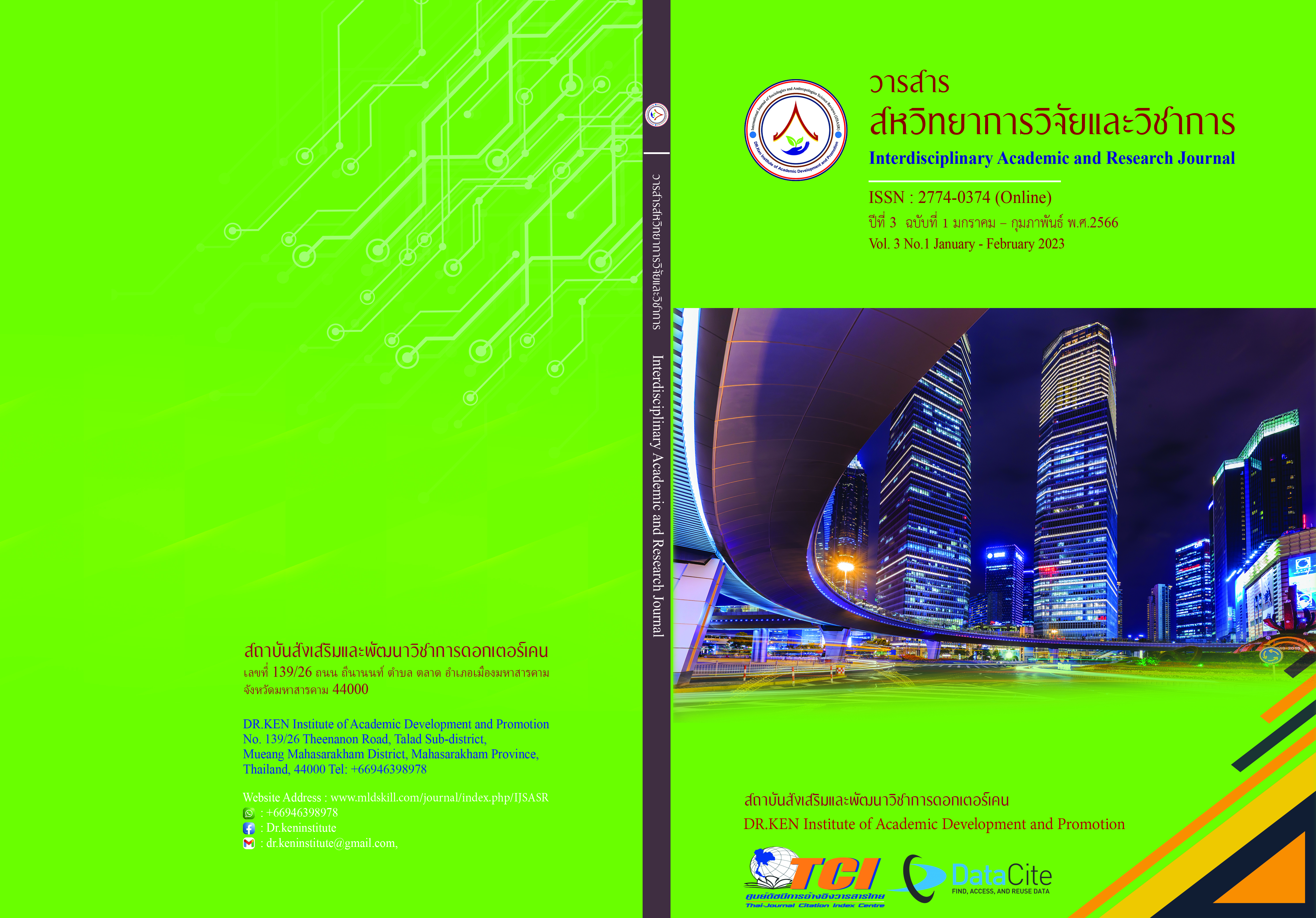Photographic Art in Digital Media Using Experiential Learning Management of Students in Bunditpatanasilpa Institute
DOI:
https://doi.org/10.14456/iarj.2023.5Keywords:
Experiential Learning; , Photographic Art; , Digital MediaAbstract
Photos in digital media play an important role in the development of innovations in the education industry. To communicate the recording of events, Stimulate awareness with a vision that can convey meaning better than speaking and listening That develops to create a variety of educational innovation media. Therefore, the experience-based learning style focuses on allowing learners to practice in real situations Observe, and review until the idea is summarized. And then applied in many situations Causing learning to meet the goal Therefore promoting learning that is focused on learners as a center causes the production of teachers to have the potential to create still images that is an important basis in the production of educational materials. Therefore, in this article, there is a desire to present the results of criticizing the art of photography in digital media. By managing experience learning in 3 issues as follows: (1) Issue 1: The results of the four-step experiential learning management. Students discussed and summarized knowledge and other findings in six areas 1) Composition, light, and shadow, proportion in photographs 2) photographic equipment for various models of smartphones and applications that support it 3) location selection and period, 4) Factors affecting photos 5) the importance of photographs that can be further developed into digital media and 6) the experiential learning management that affects photography practice. (2) Issue 2: Correspondence of photographic art and experiential learning management with educational goals. 1) Experiential learning management should focus on learners' attention using smartphone technology as a communication tool in daily life, recording still images, when learners learn what they are interested in that, shows meaningful learning and sustainable knowledge 2) focusing on practicing the 4 Cs learning skills that are relevant to 21st-century learners, resulting in durable and practical learning and 3) the art of still life photography is the heart of multimedia creating that is effective in human learning. And (3) Issue 3: Guidelines for an experiential learning management approach in the production of photographic art educational media in digital media as follows: 1) Choose the context, place, and person that corresponds to the content to practice in real places 2) When the learners have faced with real experiences 3) organize activities to exchange, discuss and find conclusions about knowledge and 4) apply knowledge to other modern media productions in the future.
References
กันตาภา สุทธิอาจ. (2561). การพัฒนารูปแบบการเรียนการสอนแบบเน้นประสบการณ์ตามสภาพจริง เพื่อส่งเสริมคุณลักษณะการเรียนด้วยการนำตนเองของนักเรียนชั้นมัธยมศึกษาตอนต้น. วิทยานิพนธ์หลักสูตรศึกษาศาสตรดุษฎีบัณฑิตสาขาวิชาหลักสูตรและการสอน มหาวิทยาลัยธุรกิจบัณฑิตย์.
ขัณธ์ชัย อธิเกียรติ และ ธนารักษ์ สารเถื่อนแก้ว. (2565). การสอนแบบทันสมัยและเทคนิควิธีสอนแนวใหม่. Retrieved on November 2, 2022 from: https://regis.skru.ac.th/RegisWeb/webpage/addnews/data/2017-07-24_078.pdf.
ทรัพสิริ เสนีวงศ์ ณ อยุธยา, สรัฐ ฤทธิ์รณศักดิ์, ณิศรา ระวียัน และวาสนา จักรแก้ว. (2564). การจัดการเรียนการสอนจากประสบการณ์ตามสภาพจริง ตามรูปแบบกิจกรรมประสบการณ์. วารสารธรรมศาสตร์ 40 (2), 116-129.
นงนุช เสือพูมี, วัลทณี นาคศรีสังข์ และประไพพิศ สิงหเสม. (2560). การจัดการเรียนรู้แบบประสบการณ์ทางการพยาบาล. วารสารพยาบาลกระทรวงสารธารสุข. 27(1), 12-21.
นพรัตน์ ชำนาญสิงห์. (2554). การสื่อความหมาย. Retrieved on November 2, 2022 from: http://pkack2.blogspot.com/.
นัยนา ดอรมาน, ประสาร มาลากุล ณ อยุธยา และผ่องพรรณ เกิดพิทักษ์. (2563). การเรียนรู้เชิงประสบการณ์และการสะท้อนคิดเชิงวิพากษ์. วารสารจิตวิทยา มหาลัยเกษมบัณฑิต. 10 (2), 20-28.
ประกาศกระทรวงศึกษาธิการ. (2562, 6 มีนาคม). ราชกิจจานุเบกษา, เล่ม 136 ตอนพิเศษ 56 ง, หน้า 12.
ราชบัณฑิตยสถาน. (2555). พจนานุกรมศัพท์ศึกษาศาสตร์ ฉบับราชบัณฑิตยสถาน. กรุงเทพฯ : อรุณการพิมพ์.
รุจโรจน์ แก้วอุไรและคณะ. (2562). การถอดบทเรียนทักษะชีวิตของนิสิตจากการจัดกิจกรรมการเรียนการ สอน รายวิชาเทคโนโลยีการถ่ายภาพ คณะศึกษาศาสตร์ มหาวิทยาลัยนเรศวร. วารสารวิทยบริการ. 30 (2), 59-68.
วราภรณ์ คล้ายประยงค์, กาญจนา ภัทราวิวัฒน์, วิชุดา กิจธรธรรม, และพิชิต ฤทธิ์จรูญ. (2564). จิตลักษณะและพฤติกรรมการเรียนรู้แบบประสบการณ์ที่ส่งผลต่อทักษะการสร้างสรรค์ งานนวัตกรรมของนักศึกษาในระบบการเรียนรู้จากการทำงานจริง. วารสารปัญญาภิวัฒน์. 13 (1), 215-231.
วินัย บุญคง. (2559). การพัฒนาเทคโนโลยีกล้องถ่ายภาพและผลกระทบ. วารสารวิจัยสหวิทยาการไทย. 11(5), 1-7.
เวทิต ทองจันทร์. (2557). กระบวนการสร้างสรรค์ภาพถ่ายดิจิทัลสำหรับใช้ในสื่อประชาสัมพันธ์ ของโรงงาน หลวงอาหารสำเร็จรูป ที่ 3 (เต่างอย) จ.สกลนคร Digital Photographic Creative Procedure for Public Relations Media of the Third Royal Instant Food Factory (Tao-ngoy), Sakolnakorn. กรุงเทพฯ : มหาวิทยาลัยธุรกิจบัณฑิตย์.
เสาวกา วิชาดี. (2554). รูปแบบการเรียนของผู้เรียนในมุมมองของทฤษฎีการเรียนรู้แบบประสบการณ์ Learner’ learning styles: the perspective from the theory of experiential learning. กรุงเทพฯ : มหาวิทยาลัยกรุงเทพ.
Bright Quotes. (2016). One Picture Says 1000 Words " A Picture is Thousands OF Meanings. Retrieved on November 2, 2022 from: https://www.youtube.com/watch?v=djrrDcF4_sk.
Constructivist Teacher. (2021). สอนให้เด็กเรียนรู้ผ่านประสบการณ์จริง. Retrieved on November 2, 2022 from: https://inskru.com/idea/-MdFxKufHRJm-KkhbL1u.
Dewey, J. (1983). Experience and Education. New York: Collier.
Dewey, J. (2005). How We Think. New York: D.C. Health and Company.
Honey, P., & Mumford, A. (1992). The manual of learning styles. 2nd edition, Maidenhead, UK:
Kolb, D. A. (1984). Experiential Learning Experience as the Source of Learning and Development. Englewood Cliffs, NJ Prentice Hall.
Lewin, M., Massini, A.Y., & Greve, H.R. (2005). Innovators and Imitators: Organizational Reference Groups and Adoption of Organizational Routines. Research Policy. 34, 550-569.
Downloads
Published
How to Cite
Issue
Section
License
Copyright (c) 2023 ธนพัต ธรรมเจริญพงศ์

This work is licensed under a Creative Commons Attribution-NonCommercial-NoDerivatives 4.0 International License.
Copyright on any article in the Interdisciplinary Academic and Research Journal is retained by the author(s) under the under the Creative Commons Attribution-NonCommercial-NoDerivatives 4.0 International License. Permission to use text, content, images, etc. of publication. Any user to read, download, copy, distribute, print, search, or link to the full texts of articles, crawl them for indexing, pass them as data to software, or use them for any other lawful purpose. But do not use it for commercial use or with the intent to benefit any business.
















.png)


